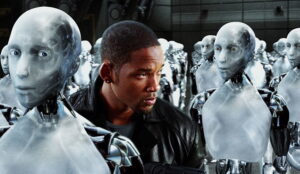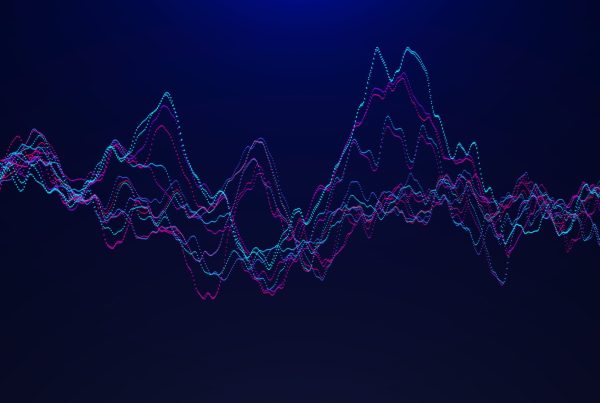The age of AI is upon us! With the help of years of sci-fi books and films of course. Everybody and anybody has envisioned a more automated future imagined from AI characters in movies. But, what is Artificial Intelligence? Does it have limits? Can we define the Stages of AI? And, should we begin to prepare for an I-robot world?
When most people think of AI, they think in a broad sense: a form of computer science that gives machines some sort of human intelligence. However, to further understand it, AI can be broken into 3 main stages:
- ANI: Artificial Narrow Intelligence
- AGI: Artificial General Intelligence
- ASI: Artificial Super Intelligence
Stages of A: 1 – ANI (Artificial Narrow Intelligence)

Often called Weak AI, ANI is the AI already embedded in our daily lives. A nice way to describe it is that ANI is super-human at specific singular tasks. Like teaching an AI machine to play chess! It will master singular tasks beyond human potential with incredible consistency.
Feel like challenging it to a game of draughts though? You’ll get a much needed ego boost. This machine can only play chess. Without prior training and programming in draughts, it doesn’t stand a chance. Think of AI as hundreds of interns capable of highly specific tasks more efficiently than humans.
ANI has already transformed the way we live, but it has its limitations. A lot of you will already interact with ANI on a daily basis, perhaps without even knowing it. Think of talking with Siri or Alexa on your smart devices, or the facial recognition that unlocks your phone when opening it!
Stages of AI: 2 – AGI (Artificial General Intelligence)

If we are to see a world like the movies with artificial intelligence, AGI will need to come into full fruition. AGI would mean a machine would be capable of understanding the world as well as any human. All while maintaining the same capacity to learn how to carry out a huge range of tasks. The reality? AGI is not yet among us. It is a hypothetical form of AI. The potential is there but some believe it to be decades away!
According to a study by Muller and Vincent C., the top-cited 100 AI researchers have a collective 90% confidence that AGI will be among us by 2070. To determine if a machine is truly AGI, it has to pass the following tests:
Turing Test
In this test, 2 humans and a machine look at something they haven’t seen and converse about it. The conversation is recorded and an evaluator determines which descriptor is the machine. The machine is only disqualified if the evaluator is positive it can identify it. To read more about it, check out Touring Test on Wikipedia.
The Coffee Test (Wozniak)
If AGI machines need to understand the world as well as humans do, they must know how to make a good coffee. In this test an AI robot is required to go into an average home and figure out how to make coffee. The test involves finding the coffee machine and adding coffee, as well as sourcing a mug and correctly brewing the hot drink.
Robot College Student Test
A literal test! The machine would take the same university classes as humans and complete the exam. Some may argue that the machine is cheating with its built-in search engines but who is going to argue with a robot…
Employment Test
This is where we should begin to worry about an I-Robot world. This test determines whether a machine can perform at least as well as humans in the same jobs!
Stages of AI: 3 – ASI (Artificial Super Intelligence)

Just when you think AI has reached its limit, we bring you the AI of all AI. Super-Intelligence is quite self-explanatory. Oxford Philosopher Nick Bostrom describes ASI as: “any intellect that greatly exceeds the cognitive performance of humans in virtually all domains of interest.” Again, this is a hypothetical agent and one which is decades away.
ASI has huge potential but it also has huge risk. Stephen Hawking feared its development could be the worst event in the history of our civilisation, and even ‘spell the end of the human race‘. If we create super-intelligent machines we may put our own existence at risk. However, right now this is just the plot for another sci-fi film.
Final Thoughts on the Stages of AI
The reality is that AI is a tool for humans to better our existence. Advancements in artificial intelligence mean the sky’s the limit! The question is – will the limit bring more positives or negatives?
As we integrate AI into our society, ethical concerns must be at the centre of our thinking. In an AI-driven society, how can we assure equality, minimise bias, and protect privacy? Will AI improve our human experience, or will it unintentionally deepen the gaps in inequality?
The desired outcome would be for AI to be an ally in the fight for a better world, but ideas must be carefully directed before they can become a reality. Furthermore, discussions around AI should not be limited to engineers or ethical thinkers; it should include everyone. Every voice, from legislators to educators, entrepreneurs to citizens, provides a crucial perspective to how we develop this technology.
We must tread carefully with AI whilst simultaneously embracing all the stages of it.
Subscribe to our newsletter
Latest Posts






